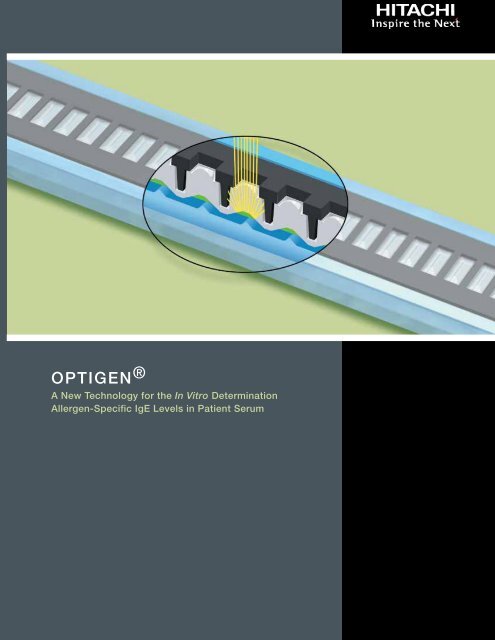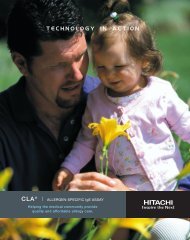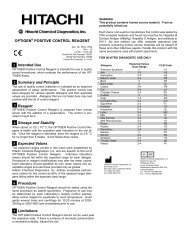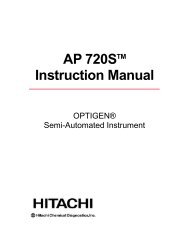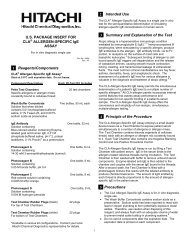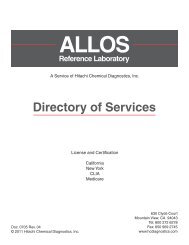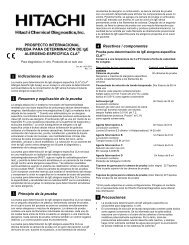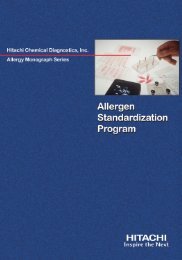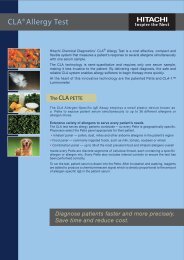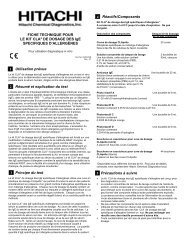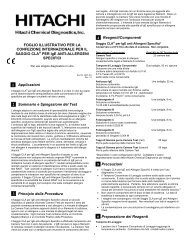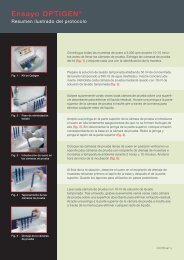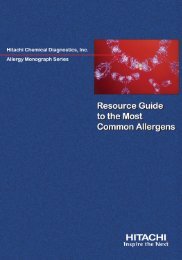OPTIGEN® - Hitachi Chemical Diagnostics
OPTIGEN® - Hitachi Chemical Diagnostics
OPTIGEN® - Hitachi Chemical Diagnostics
You also want an ePaper? Increase the reach of your titles
YUMPU automatically turns print PDFs into web optimized ePapers that Google loves.
OPTIGEN ®<br />
A New Technology for the In Vitro Determination<br />
Allergen-Specific IgE Levels in Patient Serum
OPTIGEN ®<br />
A New Technology for the In Vitro Determination<br />
of Allergen-Specific IgE Levels in Patient Serum<br />
CONTENTS<br />
4 Introduction<br />
4 The Device<br />
7 Extraction Process and Quality Control<br />
9 Manufacturing Process<br />
11 Qualification Procedure<br />
11 The Universal Panel 20<br />
12 Performance<br />
13 Features
I Introduction II The Device<br />
The use of in vitro diagnostic methods for the determination of allergen-specific IgE<br />
in human serum has been widely used in the management of allergic disease. <strong>Hitachi</strong><br />
<strong>Chemical</strong> <strong>Diagnostics</strong>, Inc. (HCD) has been a leader of the panel approach for allergy<br />
diagnosis with the use of the CLA ® Allergen-specific IgE Assay. HCD has developed a<br />
new technology, OPTIGEN ® , which allows for multiple allergen testing with a significant<br />
reduction in patient serum volume and delivers results in a few hours. The technology<br />
consists of a new device that is backwards compatible with all current<br />
instrumentation in the field and maintains the multiple allergen format of panel testing.<br />
The objective of this monograph is to describe this new technology.<br />
The new device consists of three injected molded parts; a pette body, a coverslip and a<br />
partition. The pette body contains a serum channel for fluid flow. The coverslip contains<br />
wells on the channel side for the binding of allergens and lenslets on the outer side for<br />
light collimation. The partition separates the individual wells for light collation. The three<br />
parts are assembled to create an enclosed device (Figure 1).<br />
Partition<br />
Coverslip<br />
Pette body<br />
Assembled OPTIGEN device<br />
Fig. 1 | OPTIGEN Components and Assembled Device<br />
4
The internal design of the new device was developed with the aid of Computational Fluid<br />
Dynamics (CFD) models and computer simulations. It consists of an array of allergen<br />
wells placed in the channel side of the coverslip, coupled with an array of corresponding<br />
protrusions on the internal side of the pette body which enhances the washing ability and<br />
fluidics of the device (Figure 2).<br />
Allergen<br />
Well<br />
Allergen<br />
Lenslet<br />
Partition<br />
Fluid<br />
Channel<br />
Coverslip Pette Body<br />
Geometric<br />
Features<br />
Fig. 2 | Cross-Section of the OPTIGEN Device<br />
5
The lenslets, designed with the aid of optics computer modeling, are on the opposite<br />
side of the allergen well in the coverslip and collimate the light output (Figures 3 and 4).<br />
Lenslet<br />
Direction<br />
of Light<br />
Coverslip<br />
Fluid<br />
Channel<br />
Partition<br />
Receptacle<br />
Allergen<br />
Well<br />
Fig. 3 | Cross-section of the Coverslip for OPTIGEN<br />
The opaque partition is inserted in between the wells to block the light emission from<br />
adjacent wells (Figure 4).<br />
Light<br />
Partition<br />
Coverslip<br />
Light Emitted<br />
from Well<br />
Fig. 4 | Cross-Section of the Partition and Coverslip for OPTIGEN<br />
6
III Extraction Process and Quality Control<br />
The allergen is one of the most critical components of an in vitro allergy test. HCD fully<br />
understands the need for tight control of both raw materials and extraction procedures<br />
in order to maintain consistent quality. Figure 5 shows the process and approvals from<br />
raw material to extract.<br />
Purchase<br />
Extract from<br />
Vendor as<br />
per HCD<br />
Specifications<br />
Purchase<br />
Raw Material<br />
from Vendor<br />
as per HCD<br />
Specifications<br />
QA<br />
Approval<br />
QA<br />
Approval<br />
Yes<br />
Reconstitute<br />
Extract if<br />
Lyophilized<br />
Extraction<br />
SDS-PAGE<br />
No<br />
Return to<br />
Vendor<br />
Scrap Extract<br />
No<br />
All Allergenic<br />
Proteins<br />
Present<br />
No<br />
Approve<br />
Extract for<br />
Immobilization.<br />
Perform Protein<br />
Determination<br />
Yes<br />
Band Present<br />
Per<br />
Specification<br />
Yes<br />
Western<br />
Blots<br />
Fig. 5 | Process from Raw Material to Extract at HCD<br />
7
Allergen vendors are screened and audited to ensure their ability to provide high quality and<br />
reproducible materials. Whenever possible, at least two sources of materials are identified<br />
for each allergen to ensure continuous supply. Extraction procedures are developed under<br />
Design Control guidelines and documented for production to allow for consistency and high<br />
quality. Each allergen is characterized and standardized to ensure that allergenic proteins<br />
are present and are immunologically active. Upon extraction, each allergen is analyzed by<br />
SDS-PAGE and major allergenic bands are identified. An example for Timothy grass can be<br />
seen in Figure 6. If the allergenic proteins are not present the extract is discarded and not<br />
used in product.<br />
Timothy Grass<br />
Fig. 6 | SDS-PAGE for Timothy Grass with Major Allergenic Proteins Identified<br />
Immunoblots are performed on extracts that contain appropriate bands in the SDS-PAGE.<br />
HCD maintains a sera library with positive and negative serum for each extract. The positive<br />
sera are selected based on their response to different allergenic proteins in the extract.<br />
An example for Timothy grass can be seen in Figure 7.<br />
8
Timothy Grass<br />
Fig. 7 | Immunoblots for Timothy Grass with Eight Positive and One Negative Serum Sample<br />
Each allergen available with OPTIGEN has gone through the extensive characterization<br />
program described above. Allergenic proteins are identified and documented; a library of<br />
specific sera is available for testing in immunoblots and later in the assay for confirmation<br />
of performance. All the characterization and qualification information is documented per<br />
allergen and is available on the manufacturing floor.<br />
IV Manufacturing Process<br />
Extracts approved by the process described above are stored for use when needed.<br />
Each lot of allergen is tested at different concentrations for selection of the optimal<br />
immobilization concentration. The coverslips are treated through a proprietary method to<br />
enhance protein attachment. Immobilization of all allergens is done using specialized<br />
equipment that can accurately dispense in the nanoliter range (Figure 8). The process is<br />
tightly controlled by determining the protein concentration of the extract prior to its<br />
application to the solid phase. Process control charts are produced to ensure that the<br />
extract concentration is within specification (Figure 9). Trends can be seen over time<br />
and used to evaluate performance.<br />
9
Approved<br />
Extract<br />
Immobilization<br />
at Different<br />
Concentrations<br />
to Determine<br />
Protein Limits and<br />
Optimal Target<br />
Concentration<br />
Concentration<br />
Selected for<br />
Each Allergen<br />
Panel<br />
Immobilization<br />
Device<br />
Assembly<br />
Fig. 8 | Summary of the Manufacturing Process for OPTIGEN<br />
Fig. 9 | Process Control Chart for the Immobilization of Wheat over Six Production Lots<br />
10
V Qualification Procedure VI Universal Panel 20<br />
A random sample of assembled devices is tested with positive and negative control sera that<br />
have been qualified for OPTIGEN. The expected performance of these sera has been characterized<br />
for different allergens and is documented. The flow of the qualification procedure is<br />
shown in Figure 10.<br />
Device<br />
Assembly<br />
Qualification with<br />
Positive and<br />
Negative Sera<br />
Specifications<br />
Met<br />
Fig. 10 | Summary of the Qualification Procedure for OPTIGEN<br />
The first marketed panel using OPTIGEN technology is the Universal Panel 20 (Figure 11).<br />
This panel was selected with the aid of allergists and pediatricians in different countries and<br />
targets the most common allergens worldwide. This panel is ideal for pediatric use due to the<br />
low amount of serum sample needed for 20 results.<br />
ALLERGEN<br />
Birch, White<br />
Ragweed Mix I<br />
Timothy Grass<br />
Mugwort<br />
Latex<br />
Soybean<br />
Rice<br />
Codfish<br />
Wheat<br />
Peanut<br />
Egg white<br />
Cow’s Milk<br />
Aspergillus<br />
Cladosporium<br />
Alternaria<br />
Dog<br />
Cat<br />
Cockroach Mix<br />
Mite p<br />
Mite f<br />
No<br />
Reject<br />
LATIN NAME<br />
Yes<br />
Release for<br />
Packaging<br />
Betula verrucosa (alba, pendula)<br />
Ambrosia elatior/Ambrosia trifida<br />
Phleum pratense<br />
Artemisia vulgaris<br />
Hevea brasiliensis<br />
Glycine max<br />
Oryza sativa<br />
Gadus morhua<br />
Triticum aestirum<br />
Arachis hypogaea<br />
Gallus gallus<br />
N/A<br />
Aspergillus fumigatus<br />
Cladosporium herbarum/Cladosporium cladosporiodes<br />
Alternaria alternata (tenuis)<br />
Canis<br />
Felis domesticus<br />
Blatella germanica/Periplaneta americana<br />
Dermatophagoides pteronyssinus<br />
Dermatophagoides farinae<br />
Fig. 11 | Allergens in the Universal Panel 20<br />
11
VII Performance<br />
The performance of this panel has been evaluated in several studies. These include studies<br />
run at HCD with samples purchased from vendors, samples from Poland and Sweden, and<br />
two site evaluations—one done in France and one done in Germany. All evaluations were<br />
performed against Pharmacia CAP. Figure 12 shows the overall assay performance with data<br />
collected at the evaluations in Germany and France. Independent operators not associated<br />
with HCD ran these evaluations after being trained by HCD personnel. The results show a<br />
sensitivity of 88%, a specificity of 94% an efficiency of 92% with a total of 1348 results for<br />
20 allergens. 90% of the OPTIGEN results were within one class of Pharmacia CAP.<br />
OPTIGEN<br />
4<br />
0<br />
1<br />
69<br />
116<br />
77<br />
3<br />
6<br />
1<br />
50<br />
29<br />
9<br />
2<br />
9<br />
8<br />
65<br />
27<br />
5<br />
1<br />
29<br />
12<br />
39<br />
14<br />
4<br />
0<br />
707<br />
40<br />
25<br />
6<br />
0<br />
0 1 2 3 4, 5 & 6<br />
Pharmacia CAP<br />
SENSITIVITY % 88% TOTAL DATA POINTS: 1348<br />
SPECIFICITY % 94%<br />
EFFICIENCY % 92%<br />
OPTIGEN<br />
1<br />
44<br />
526<br />
OPTIGEN vs. CAP<br />
0<br />
707<br />
71<br />
C<br />
No.<br />
%<br />
W/1C<br />
0 1<br />
Pharmacia CAP<br />
=<br />
+1<br />
890<br />
203<br />
66.02%<br />
15.06%<br />
90%<br />
-1<br />
115<br />
8.53%<br />
+2<br />
79<br />
5.86%<br />
-2<br />
44<br />
3.26%<br />
+3<br />
7<br />
0.52%<br />
-3<br />
10<br />
0.74%<br />
Fig. 12 | Performance of the Universal<br />
Panel 20 in Comparison to<br />
Pharmacia CAP.<br />
Total<br />
1348<br />
100.00%<br />
Studies to determine the effect of high concentrations of total IgE were done by adding increasing<br />
concentrations of myeloma to a negative serum sample. The results showed no significant background<br />
increase with increasing concentrations of IgE up to 10,000 IU/ML.<br />
12
VIII Key Features of OPTIGEN<br />
Key Features of OPTIGEN:<br />
• Approximately 300 µL of serum for 20 allergens.<br />
• Assay time less than 5 hours: 2 hours serum incubation and 2 hours conjugate incubation.<br />
• Semi-quantitative results reported in classes from 0 to 4.<br />
• Availability of a positive control serum with suggested ranges for several allergens for<br />
quality control.<br />
• Availability of a negative control serum for quality control.<br />
• Minimal hands-on time.<br />
• Easy set up, all allergens included in the device.<br />
• No allergen inventory needed at the testing site.<br />
• Easy procedure.<br />
• Backwards compatible with CLA-1 Luminometer instrumentation.<br />
13
With its headquarters in the heart of Silicon Valley and offices around the<br />
world, <strong>Hitachi</strong> <strong>Chemical</strong> <strong>Diagnostics</strong> is a global leader of in vitro allergy<br />
diagnostics with a legacy of innovation. <strong>Hitachi</strong> <strong>Chemical</strong> <strong>Diagnostics</strong><br />
was the first company to introduce a multiple diagnostic test for allergies<br />
and one of the first to introduce a chemiluminescent assay system for<br />
the detection of lgE antibodies. In addition to OPTIGEN, HCD also produces<br />
the reliable CLA ® Allergy Test and the AP 720S Semi-<br />
Automated Instrument.<br />
United States Office<br />
<strong>Hitachi</strong> <strong>Chemical</strong> <strong>Diagnostics</strong>, Inc.<br />
630 Clyde Court<br />
Mountain View<br />
CA 94043-2239<br />
650.961.5501<br />
800.233.6278<br />
www.hcdiagnostics.com<br />
<strong>Hitachi</strong> <strong>Chemical</strong> <strong>Diagnostics</strong>, an integral member of the <strong>Hitachi</strong> Group,<br />
works with industry leaders, laboratories and distributors around the<br />
world to provide the medical community access to the latest in vitro allergy<br />
testing technology. <strong>Hitachi</strong> <strong>Chemical</strong> <strong>Diagnostics</strong> is committed to innovation,<br />
heritage, and the strength of the <strong>Hitachi</strong> brand. Our products are<br />
marketed to over 40 countries worldwide. To learn more about <strong>Hitachi</strong><br />
<strong>Chemical</strong> <strong>Diagnostics</strong> and OPTIGEN, please contact us or your local<br />
representative, or visit us on the web at www.hcdiagnostics.com.<br />
European Office<br />
<strong>Hitachi</strong> <strong>Chemical</strong> <strong>Diagnostics</strong>, Inc.<br />
<strong>Hitachi</strong> Europe Ltd.<br />
Whitebrook Park<br />
Lower Cookham Road<br />
Maidenhead, Berkshire, SL6 8YA<br />
United Kingdom<br />
44 (0) 1628.585.590<br />
©<strong>Hitachi</strong> <strong>Chemical</strong> <strong>Diagnostics</strong>, Inc. All rights reserved.<br />
Doc.No. 0676 Rev. 01<br />
OPTIGEN is a registered trademark and CLA-1is a<br />
trademark of <strong>Hitachi</strong> <strong>Chemical</strong> <strong>Diagnostics</strong>, Inc. in the<br />
United States and other countries.


